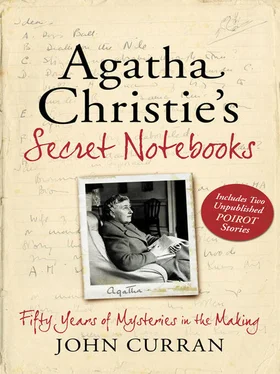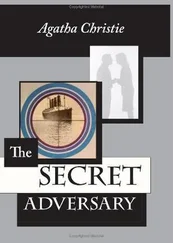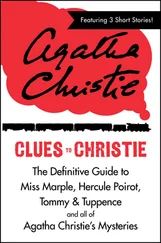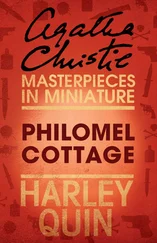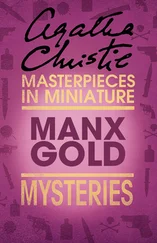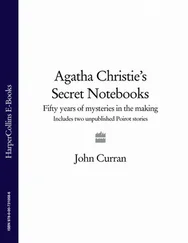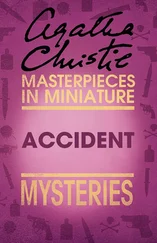Dr Haydock—getting old—Miss M says can’t knit—Dr H suggest unravel—you’ve always had an interest in murder to say nothing of more than your fair share of it. Proceeds to tell her a story.
At the Development—a girl looking over a house has a nasty fall—has man with her pushed her
Dr H’s story—Is it story of Clocks—typist—blind woman—dead man
Miss M with Jenny in West Indies—the frog faced Major—his gossip—glass eye—appears to be looking different direction from what he really is
Eventually she settles on the ‘Development Murder’ (as it is referred to throughout) as her next novel and gets down to the serious plotting. This is the 71-year-old Agatha Christie still working at full creative stretch at an age when most people have retired:
Jessica Knight—M asks her to go to chemist? Then she gets up, slips her coat on and goes for walk. The Development—entering a strange country—scraps of talk—near accident? Man and girl—looking at cottage—her fall—Heather Badcock
Notebook 4 has the germ of the idea that is the main plot device of the book:
The Rubella idea—Reason for crime—child has been born defective owing to one natal infection—while the ‘fan’ has grim determination not to miss meeting her idol
And Notebook 8 develops this further with a rough sketch of the first few chapters:
Development Murder
Chapter I Miss Marple and Development—her walk—when old place was Protheroes—the Bantry’s—young women who remind her of various people—then a Hilda Glazebrook—one of those tiresome gushing women. Patience Considine—Actress and Film star—Hilda’s hero worship—bit about German measles—no ill effects—P’s look—as though frozen
The contentious four words (‘bit about German measles’) appear very near the beginning of the notes, indicating Christie’s intention of playing dangerously fair with the reader. In the event she rewrote this and other similar references, and avoided mentioning German measles until very near the end of the novel.
The bulk of the plotting of this title is in Notebook 52, although from the ease of the sequence it would seem that she already knew where she was going with it. Once the setting of Gossington Hall and its new inhabitant was decided, and the rubella idea established, the book was smoothly drafted:
Miss M unravelling—Marina Gregg buys Bantrys old house—Mrs B in lodge
Her husband Arthur Rossiter (?) quiet intelligent man—dark horse?
Heather Beasly (?) in a ‘development’ house—Miss M—out walking—falls down—Heather picks her up—cup of tea—talk etc. about Marina Gregg? Story of H. going with measles etc.—Mr Beasley bank clerk? Insurance agent? House agent? School teacher?
Encounter between M[arina] and H[eather]—husband there (Does Mrs B recount all this later to Miss M?)
Some nonsense H said (first mention of G measles?)—Well M answered her—but there was a minute or two—and she said it quite absent-mindedly and as though she was thinking of something else—mechanically—said it so often before—but her eyes staring—over Heather’s head—as though she saw something—something terrible—at what?
Well—staircase
Who was coming up
The idea of looking over the shoulder and seeing something amazing/frightening/puzzling features in a few Christie novels and in each case she comes up with a credible and completely different situation. The earliest example is in The Mysterious Affair at Styles, followed a few years later by another instance in The Man in the Brown Suit. Significant other cases in point are included in Appointment with Death and Death Comes as the End. Two years after The Mirror Crack’d from Side to Side, she presents us, and Miss Marple, with a similar puzzle when Major Palgrave sees something disturbing over Miss Marple’s shoulder in A Caribbean Mystery. The answer to that riddle is her most daring and original solution to the over-the-shoulder theme and may, indeed, have been inspired by the reference to Nelson in the extract below.
A minor point about The Mirror Crack’d from Side to Side is the fact that Mrs Bantry relates all of the dramatic events of the reception back to Miss Marple. Why did Christie not arrange, under some pretext, that Miss Marple attend the party herself? This could have been easily set up and would have overcome the necessity to construe Marina’s actions as filtered through a third, and sometimes fourth, person. But perhaps this is the very reason that she did not. Miss Marple would have seen too much and too easily. As it is, the jogging of the arm and the dropping of the sleeping draught into the glass is glossed over, although in reality it would have been difficult to stage-manage. This is also one of the few examples of the use of a fictitious poison in a proprietary medicine.
For the most part the people Christie originally listed (or versions thereof) appear in the finished book:
Now People
Kathleen Leila Carlyn [Margot Bence]—adopted child from slum family—mother wrote letter—then her own [Marina’s] child comes—she makes settlement on adopted children—girl and 2 boys—
Does Lara come to board with Cherry—(a pal her sister has picked up) or working somewhere as hairdresser or as a photographer (best?)
Ella Schwarz [Zeilinsky]—social secretary—in love with Jason
Heather’s husband Arthur
Mary Bates—a widow—husband dead in a rather peculiar way (car accident?)
Carlton Burrowes—surprise guest—used to know Marina
Who were on stairs or coming up?
Ms Sage—just over his head—frozen stare—at what—or whom?
A. Picture on wall—subject? Death of Nelson!!
B. Carlton Burrowes—Alfred Klein—one a friend
C. The other brought by him
D. A photographer girl from Homes and Gardens
E. Ella Schwarz
F. Arthur Badcock
G. Mary Baine
H. Very elderly man
Another unfortunate, and utterly unbelievable, coincidence is presented in this novel. Even the most devoted Christie fan cannot accept that Arthur Badcock, who is portrayed and perceived as a dull and insignificant man, was once the husband of famous, glamorous Marina. In Chapter 8 iii he is described as looking like ‘a piece of chewed string. Nice but wet.’ True, Marina’s first marriage, ‘an early one which didn’t count’, is mentioned in Chapter 3, but to accept that he happens to live in the small village where she happens to buy a house, that neither of them mention it and that no one else is aware of it, is expecting too much of the reader’s indulgence. Why this complication was introduced at all is difficult to explain. Christie knew her readers better than to ask them to accept that this implausible revelation would form a part of the solution and so, as Arthur is only briefly, and never convincingly, considered as a possible murderer it would seem a complication too far. For sheer unbelieveability this coincidence ranks with the revelation of Miranda’s parentage in Hallowe’en Party, the identity of Louise Leidner’s first husband in Murder in Mesopotamia and that of Stodart-West’s mother in Four-Fifty from Paddington.
She recovers herself—usual charm to Heather—Dormil—uses it on her—H. puts it down (to talk) M. puts hers down—to stretch out both hands turning round—knocks H’s drink—have mine—tomato juice instead
The ‘Homes and Gardens’ photographer, Margot Bence, carries echoes of the adopted children in Ordeal by Innocence from four years earlier. And the widow Mary Bates (subsequently listed as Baine) does not figure in the story; Carlton Burrowes may be an early version of Ardwyck Fenn.
Читать дальше
Конец ознакомительного отрывка
Купить книгу
